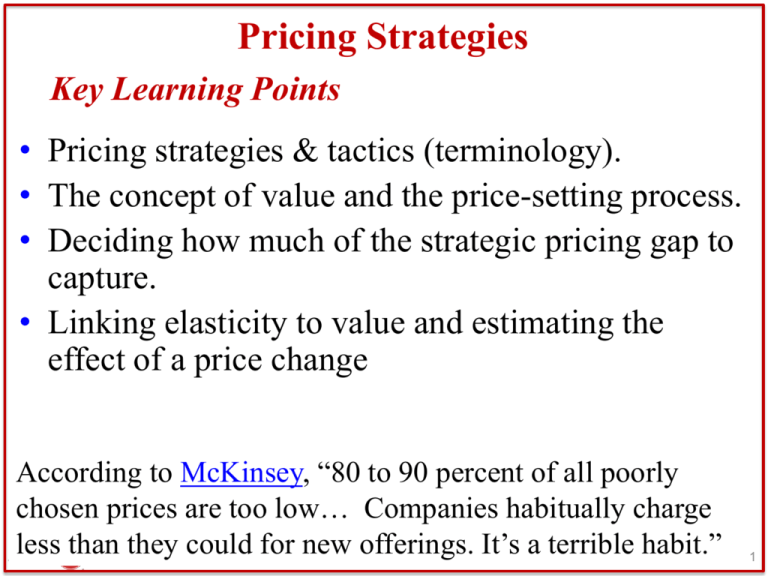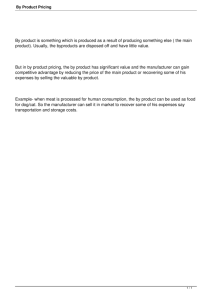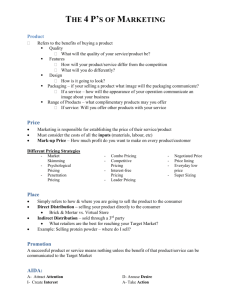The Price Setting Process
advertisement

Pricing Strategies Key Learning Points • Pricing strategies & tactics (terminology). • The concept of value and the price-setting process. • Deciding how much of the strategic pricing gap to capture. • Linking elasticity to value and estimating the effect of a price change According to McKinsey, “80 to 90 percent of all poorly chosen prices are too low… Companies habitually charge less than they could for new offerings. It’s a terrible habit.” 1 Pricing Strategies • Customer Value Pricing (Demand-focused pricing) Sets price based on the relative sharing of differentiation value); Company Objectives determine how much value to share or capture: • Penetration or Market Share Pricing – Gives most value to customers, builds share & goodwill & erects entry barriers; elastic demand, no sustainable advantage, market share objective… • Skimming or Prestige Pricing – Majority of value goes to firm to maximize profits – invites competitive entry; inelastic demand, multiple price segments, sustainable advantage… • Intermediate or Neutral Pricing – Equal sharing of value • Technical, Cost-focused Pricing • Full-Cost Pricing – Markup, Breakeven, Rate-of-return – Ignores competition and customer; most useful in stable supply & demand situations or unique, bidding situations with high uncertainty • Variable-Cost Pricing – Ignores fixed costs; useful to stimulate or shift demand for perishable offerings with seasonal demand. 2 Customer -- Psychological Aspects of Price • Value Is the Ratio of Perceived Benefits to Price – Evaluated by comparing focal offering to a reference value – Creates a price window for competitive offerings 3 The Price Setting Process Define Price Window Set initial price range based on differential value & relevant costs Key Questions: •What is the role of costs in setting my initial price range? •What is appropriate price ceiling for this product? •How should I incorporate reference prices into my price window? Set Initial Price Communicate Prices to Market Develop communication plan to ensure prices are perceived to be fair Key Questions: Key Questions: •Is price consistent with my •What is the best way business strategy & to communicate price objectives (skimming vs. (changes) to penetration)? customers? •What are the non-value •What are the related determinants of considerations for price sensitivity? implementing •What are the pricesignificantly higher volume tradeoffs & prices? impact on profitability? Determine amount of differential value to be captured Using Competitive Information to Define Price Window Brand Product of Notes Price per Ounce ($) Price per Gallon ($) Acqua Panna – Natural Spring Italy (Florence) 1 liter glass bottle 0.13162 16.85 Arrowhead – Mountain Spring California Plastic 28-pack 0.02367 3.03 Dasani – Purified Drinking Water USA Plastic 0.08876 11.36 Evian (Nomad) – Natural Spring France (Alps) Plastic 6-pack 0.12318 15.77 Menehune – Purified Drinking Water Aiea, HI Plastic 0.07813 10.01 Perrier – Sparkling Natural Mineral France Green Glass 0.08333 10.67 Rosauer’s Finest – Spring Water Canada Plastic/Pop Top 0.02307 2.95 San Pellegrino – Sparkling Mineral Italy (S.P.) Green Glass 0.08844 11.32 Talking Rain – Mountain Spring Preston, WA Plastic/Flavored 0.06760 8.65 Voss – Virgin aquifer Norway Clear glass cylinder 0.181746 23.26 Pipes/Lake Water 0.000012 0.00156 City of Dallas– Residential The relevant question is: Why are consumers willing to pay relatively steep prices for a commodity product? Competitive Water Prices & the Price Window Number of competitive offerings 6 5 4 Neutral or Intermediate Prices 3 Penetration Prices Skimming Prices 2 1 0 0-$2.5 $2.5-$7.5 $7.5-$12.5 $s per Gallon $12.5-$17.5 >$17.5 Conceptualizing the Price Window and Market Segments with a Normal Bell Curve Value Buyers Price Sensitive Price Insensitive Low Price Hi Price Penetration Pricing Intermediate Pricing Price Skimming Non-normal Distributions with Kinks Suggest Different Segments Frequency of Observed Price Points Observed Prices for Milwaukee’s Best, Miller, Budweiser & Michelob 160 140 120 100 80 60 40 20 0 5.00 10.00 15.00 20.00 25.00 $s per Gallon 8 Price Windows for Milwaukee’s Best, Bud & Miller, and Michelob Frequency of Observed Price Points 80 70 60 50 40 30 20 Price Driven 10 Value Driven Brand Driven 0 $5 $10 $10 $15 $15 $s per Gallon $20 $20 $25 $25 The Price Setting Process Define Price Window Set initial price range based on differential value & relevant costs Key Questions: •What is the role of costs in setting my initial price range? •What is appropriate price ceiling for this product? •How should I incorporate reference prices into my price window? Set Initial Price Communicate Prices to Market Develop communication plan to ensure prices are perceived to be fair Key Questions: Key Questions: •Is price consistent with my •What is the best way business strategy & to communicate price objectives (skimming vs. (changes) to penetration)? customers? •What are the non-value •What are the related determinants of considerations for price sensitivity? implementing •What are the pricesignificantly higher volume tradeoffs & prices? impact on profitability? Determine amount of differential value to be captured Economic Value Estimation Framework Your unique value delivery Price of Next Best Competitive Alternative Positive Differentiation Value Competitive Reference Value Negative Differentiation Value Price to capture a share of this value Costs unique to doing business with you Total Economic Value 11 Defining the Price Window (& Objectives) Positively Differentiated Offering Negatively Differentiated Offering Neutral or Intermediate Pricing Price skimming captures high margins at the expense of sales volume. Prices are high relative to what the “middle market” is willing to pay. Viable when the profit from the price-insensitive segment exceeds profit from sales to larger market at lower price. Penetration pricing sets price far enough below economic value (not below cost!) to attract and hold a large base of consumers. Generates sales volume (& lower marginal costs) at the expense of higher margins. 12 Customer -- Psychological Aspects of Price • Value Is the Ratio of Perceived Benefits to Price – Evaluated by comparing focal offering to a reference value – Creates a price window for competitive offerings • Linking Elasticity and Value Estimates – As differential value increases, elasticity decreases – Marketers can effectively use price to signal quality when: • Consumers lack information • Product quality is difficult to assess before (experience goods) or even after (credence goods) purchase 13 Estimating Customer Value MKTG 6223: Understanding What Customers Value MKTG 6214: Advanced Pricing Management Estimating Customer Value • Economic Value Method • Quantify the objective value of attributes • Survey-Based Methods • Self-report willingness-to-pay • Conjoint studies • Direct Purchase Observation • Estimate price elasticity based on purchase data, perhaps in conjunction with an experiment Financial Analysis in Marketing K&P Chapter 2 • • • • • • Marketing Pro Formas Breakeven Analysis Customer Lifetime Value (CLV) Sales Forecasts Demand Elasticity Channel Margin Calculus 15 Price Experiment for Mobile Phone Inelastic demand -.50 Elastic demand -2.83 Demand Elasticity wrt Price Necessary to Evaluate Price-Volume Trade-offs % change in demand E = % change in price Price D from 1200 900 Ecar phone= (24% - 41%)/24% (1200-900)/1200 = -2.83 Price D from 600 900 Ecar phone= (41% - 45%)/41% (900-600)/900 = -.50 If the absolute value of E is < 1.0, demand is inelastic If the absolute value of E is > 1.0, demand is elastic 17 Price Elasticity – a visual representation . . . . P2 P1 Elastic: customers are very sensitive to price changes when there is no differential advantage between substitutes – grains, fruits and vegetables, paper clips, rubber bands P2 Price elasticities on average ≈ -2.5 unit elastic (i.e., e = -1) P1 Inelastic: customers are not very sensitive to price changes when there is strong differential advantage and few substitutes – gemstones, transplant organs Q2 Q1Q2 Q1 Quantity Demanded 18 Break-even (B/E) Sales Analysis Formula Price Change (No change in costs): % B/E unit sales D = — %DP or %CM’ + %DP — $DP $CM’ + $DP For example, your current contribution margin is 50%; that is, unit variable costs are 50% of price What % unit sales increase is necessary for a 10% price decrease to breakeven? — %DP 10% = %CM’ + %DP 50% - 10% B/Ee = 25% -10% = = -2.5 10% 40% = 25% Estimating the Effect of a Price Change See Kerin & Peterson, Ex. 8.2 Cost, Volume, and Profit Data Unit sales volume 1,000 1,000 Unit selling price $10 $10 Unit variable cost $5 $2 Unit contribution (margin) $5 50% $8 Fixed costs $3,000 $6,000 Net profit $2,000 $2,000 80% Break-even Sales Change PD% QD% e QD% e For a price reduction of -20% 66.7% -3.3 33.3% -1.7 For a price reduction of -10% 25.0% -2.5 14.3% -1.4 For a price reduction of -5% 11.1% -2.2 6.7% -1.3 For a price increase of 5% -9.1% -1.8 -5.9% -1.2 For a price increase of 10% -16.7% -1.7 -11.1% -1.1 For a price increase of 20% -28.6% -1.4 -20.0% -1.0 20 Collaborators -- Channel Margin Analysis Cases May Require Price-Setting to Intermediaries Planned Prices and Margins for a Software Product Retail Price $400 Retail Price $500 RM 40% Wholesale Price $240 Wholesale Price $300 Manufacturer Price $240 WM 20% GM 50% Manufacturer Price $192 GM goes to 72/192 = 37.5% Cost of Goods Sold $120 Cost of Goods Sold $120 COGS 50% Or reduce COGS 20% to $96 What if you wanted a $400 MSRP? 21 Unit Profit Margin Analysis Altius Weighted Average Victor TX Victor 70% 30% $45.30 $48.00 $39.00 $27.00 Retailer gross profit $6.80 $7.20 $5.85 $5.40 Retailer gross margin % 15.0% 15.0% 15.0% 20.0% Current Share of Sales Retail price 70% x 48 + 30% x 39 = Manufacturer price $33.15 Manufacturer variable cost 30% $9.95 Manufacturer unit contribution 70% $23.21 Manufacturer gross margin % Value of market share point ($M) Elevate 70% 70% ? ? 70% ? $7.75 64% ? 22 Current Market Share and Gross Profit for Altius's Product Line Altius Market share, retail dollar sales (%) Victor TX Victor $266.6 $0.00 $0.00 15.0% 15.0% 15.0% 70.0% 70.0% 70.0% 70.0% 30.0% 55.2% Unit volume (M) Retail sales ($M) - 55.2% of $483M Retailer gross margin (%) Manufacturer sales ($M) Manufacturer gross margin (%) Gross profit ($M) Victor TX 70% of unit volume Market share, unit sales (%) 45.2% 23 Victor Price Cut Analysis Current price Retail price Retailer margin Altius price Altius variable cost Altius unit contribution Altius gross margin $39 15% $33.15 $9.95 $23.21 70% $2 Retail Price Cut $4 Retail Price Cut $37 15% $31.45 $35 15% — $DP BE= $CM’ + $DP = — %DP BE= %CM’ + %DP = Altius Manufacturer Price Change % -5.1% Unit sales increase to maintain profit 7.9% - -1.70 23.21-1.70 - -5.1% 70%-5.1% % Retail price change Elasticity required to break even Victor Market Share increase required to break even Victor Market Share required to break even Altius Market Share required to break even 24 The Price Setting Process Define Price Window Set initial price range based on differential value & relevant costs Key Questions: •What is the role of costs in setting my initial price range? •What is appropriate price ceiling for this product? •How should I incorporate reference prices into my price window? Set Initial Price Communicate Prices to Market Develop communication plan to ensure prices are perceived to be fair Key Questions: Key Questions: •Is price consistent with my •What is the best way business strategy & to communicate price objectives (skimming vs. (changes) to penetration)? customers? •What are the non-value •What are the related determinants of considerations for price sensitivity? implementing •What are the pricesignificantly higher volume tradeoffs & prices? impact on profitability? Determine amount of differential value to be captured Happy Pricing! Review Questions • What are 2 Customer Value Pricing (i.e., Demandfocused Pricing) strategies? • What are 2 Cost-focused Pricing strategies? • How do we define value? • What are the three steps in the Price-Setting process? • What is the link between pricing strategy and competitive advantage? 27





